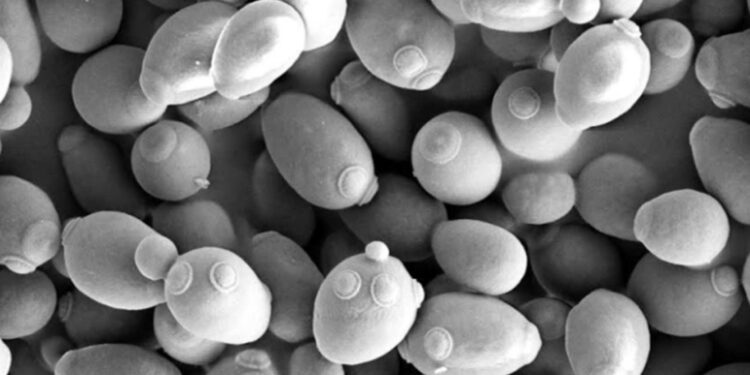Saccharomyces cerevisiae, SEM image. Credit: Mogana Das Murtey and Patchamuthu Ramasamy/CC BY-SA 3.0
When diastatic strains of Saccharomyces cerevisiae, or brewer’s yeast, land in the wrong place, they can become a craft brewer’s nightmare. Diastatic yeasts are variant strains of yeast that secrete glucoamylase, an enzyme that can break down dextrins into simple sugars, which can ruin fresh beer by increasing alcohol content, changing flavor, and in the worst cases, causing bottles to explode.
One way to fix the problem before the bottles start breaking might be to hide them in plain sight. Applied and environmental microbiologyA group of brewers and microbiologists report that the solution to this yeast problem may lie in other yeasts. The researchers found that proteins called killer toxins, produced naturally by many strains of S. cerevisiae, suppress diastatic strains and may help stop the problem.
“When diastatic contamination occurs, most of the time you throw away the beer, which is expensive,” says microbiologist and lead author Paul Rowley, Ph.D., of the University of Idaho. “What we show in the paper is that we can add the killer yeast at the point of contamination. It’s a remediation procedure that prevents diastatic strains from growing.”
Diastatic strains of S. cerevisiae play a major role in brewing Belgian-style saison beers, which typically have higher alcohol content than other styles. The problem arises, Rowley says, when these strains get mixed into lagers and other types and trigger secondary fermentation. Although many breweries have rigorous monitoring methods in place to prevent contamination, the strains can go undetected.
“If you look at these strains on an agar plate, you can’t see the morphological difference,” he said. The only difference, he said, is that diastatic yeasts have a genetic modification that gives them an extra ability to break down residual starches. “The yeast looks like yeast.”
Large breweries avoid the problem by pasteurizing beer, but the process is expensive and some smaller breweries worry that pasteurization will alter the taste, says Nicholas Ketchum, a microbiologist at Rhinegeist Brewery in Cincinnati, Ohio, and a co-author of the new study. One of his responsibilities at Rhinegeist is to monitor diastatic contamination.
The research began a few years ago, when Ketchum was teaching applied microbiology and brewing at a Cincinnati community college. While preparing a talk on wild yeasts and killer toxins, he realized that these proteins might offer a low-cost way to address diastatic contamination. He conducted some experiments, presented preliminary results at the World Brewing Congress in 2020, and discussed the work on a beer brewer’s podcast, where the mention of killer yeasts caught Rowley’s attention.
Researchers in Rowley’s lab, including undergraduates Victor Zhong and Ximena Garcia, challenged 34 diastatic strains of yeast with Saccharomyces strains that produce eight known deadly toxins. The most effective toxin, K1, prevented the growth of more than 91 percent of the diastatic strains tested.
The next step is to better understand the mechanism, Ketchum said, and find a way to make it broadly useful to craft brewers. “There are more unknowns than knowns” about the process, he said. The effectiveness of the toxins, for example, appears to depend on the total amount of yeast in the mix, not just the diastatic strains. Rowley is also currently studying the extent of the problem among small brewers.
Rowley continues to look at deadly toxins, which have not yet been well studied. “Yeasts are a lot more complicated than you might think,” he said.
More information:
Applied and environmental microbiology (2024). is what je.org/10.1128/aem.01072-24
Provided by the American Society for Microbiology
Quote:Deadly Toxins Produced by Yeast May Help Fix Craft Beer Brewing Problem (2024, September 12) Retrieved September 12, 2024, from
This document is subject to copyright. Apart from any fair dealing for the purpose of private study or research, no part may be reproduced without written permission. The content is provided for informational purposes only.



